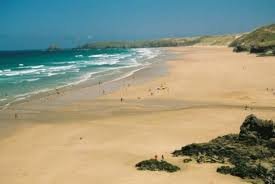


Classic family holiday beach resort
Web: www.perranporthinfo.co.uk
Web: www.visitcornwall.com/destinations/perranporth
Perranporth is half way along the north coast on the B3285, about eight miles south of Newquay, and is well served by a road network, enabling one to travel to all parts of Cornwall whether by car or coach. Coach trips to all parts of the Duchy are available and can be booked at the Information Centre, where also you can purchase maps to enable you to explore the footpaths in the remote areas, including the Cornwall Coastal Footpath. You will see wildlife and rare birds and if you come in the spring every hedgerow and cliff-top is a multi-coloured carpet of wild flowers. The village had a population of 5,737 in the 2011 census.
It is no exaggeration to say that the history and development of Perranporth have been dominated by sand. Perranporth today has become a popular holiday resort thanks to its long stretch of golden sands which extends north-west from the town for nearly two miles and the beach is a popular surfing location, but the effects have not always been so positive. In the extensive dune system just inland, two ancient religious sites have been lost to the encroaching sands. St. Piran's Oratory, an important early Celtic monastery which became one of the foremost places of pilgrimage in medieval Cornwall, became overwhelmed by sand sometime before 1500. Following its excavation in the last century, it had to be re-buried in 1981 to protect the structure and the site is now marked by a memorial stone. Nearby are the ruined walls of the parish church, originally built around 1150. This building was abandoned to the sand in 1804. Beside it is a fine cross which may date from the 10th century or earlier. A festival is held on the 5th of March every year to celebrate St. Piran.
North-east of the village is the Piran Round, an Iron Age hill camp. It is believed the amphitheatre was once used for games and mystery plays. At the opposite end is a more recent addition, the giant cliff top Millennium Sundial.
Perranporth Airfield was a Spitfire Station during the Second World War. It was opened in April 1941 and de-commissioned in April 1946. Pilots from many different countries flew from here and there is a roll of honour, in the control tower, commemorating those who lost their lives. English Heritage considers this to be one of the most important remaining airfields from the Second World War and there are still many interesting features to be seen. Today the airfield is devoted to gliding and leisure activities and scenic flights operate from here.
Atop the cliffs overlooking Perranporth Beach near Droskyn Car Park in Cliff Road, this mammoth sundial, which is technically known as the Perranzabuloe Millennium Sundial but sometimes even called the Droskyn Sundial, is a marvellous sight. It was unsurprisingly commissioned in 2000 given its full name and features a full circle of ancient standing stones made out of granite. At its centre is a 20 foot stainless steel gnomon, which is the part of a sundial that casts a shadow so that we can tell the time.
The sundial was designed by local lad Stuart Thorn with the distinct purpose of telling ‘Cornish time’ instead of the usual Greenwich Mean Time. That basically means that the gnomon’s shadow points due north when the sun is at its highest and that’s actually 12 minutes earlier than GMT.
Quaint villages abound in the area and nearby lies Trerice Manor, owned by the National Trust. Bolingey is a hamlet, situated a mile from Perranporth charming and picturesque, with a pretty 17th century inn, Bolingey is surrounded by miles of footpaths and bridleways. it is at the beginning of Penwartha Coombe (Coombe meaning valley), with a stream running alongside the road with banks of wild flowers and trees a very cool and refreshing walk away from the busy streets of Perranporth and well worth a visit.
The 'Voorspoed' ran ashore in a northerly gale in Perran Bay on 7th March 1901, while travelling from Cardiff to Bahia. The wreck was one of the last to be looted.
Perranporth used to have a railway station on the branch line from Chacewater to Newquay. It was opened in 1903 and closed in 1949.
On the 10th July 2016 a 40 foot sperm whale was washed up dead on Perranporth beach.
Surfing is popular in Perranporth with its long sands and beach break. Te beach is a destination for kite surfing enthusiasts. There is a golf club, Perranporth Golf Club, just north of the town, while the football team Perranporth A.F.C. play in Division One West of the South West Peninsula League. There is a rugby club, "The Brewers", and a tennis club.
The town's Tourist Information Centre is at Westcott House, St. Piran's Road, TR6 0BH.
Winston Graham (1908-2003), author used to live here and it is where he wrote the series of Poldark novels.
Donald Healey (1898-1988), The famous motor engineer and designer was born in Perranporth. After serving with the RAF during the war, he opened a garage in the town. He died at his home in Perranporth.
Perranporth Shout - third weekend in April.
Perranporth Carnival - Mid July
Boxing Day Swim - December
Perranporth Youth Hostel Cornwall's Beaches Healeys Cornish Cyder Farm Surfing in Cornwall
Holywell St. Agnes Perranzabuloe Folk Museum The Coastal Footpath